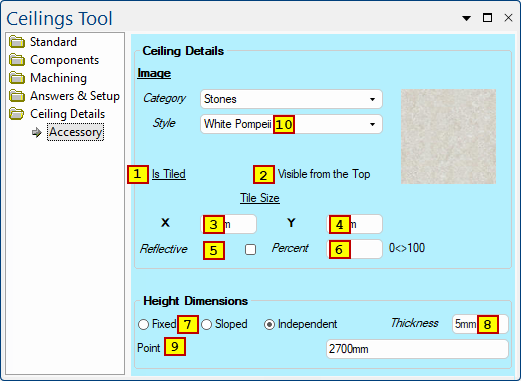


Any controls on this page which can be accessed with a formula are marked with a reference number.
To view the variable name, hold your mouse over the control or click on  the control to look up the reference in the table below.
the control to look up the reference in the table below.
For more information on other pages or categories, simply click on the area of interest.
To find out what this property page is used for, see discussion on Ceilings Tool under Drawing Tools.
| Ref | Variable Name |
|---|---|
| 1 | IsTiled |
| 2 | TopViz (see Note 3 below) |
| 3 | TileWidth |
| 4 | TileDepth |
| 5 | IsReflect |
| 6 | ReflectPer |
| 7 | SlopeMode (see Note 1 below) |
| 8 | CDepth (see Note 3 below) |
| 9 | (See Note 2 Height) |
| 10 | CeilingStyle |
Extensive support for floors and ceilings was added early in ver12.0 development and includes capabilities for making ceilings with peaks and valleys, etc.
The selection of the radio button sets the value of SlopeMode i.e.
- Fixed = 1
- Sloped = 2
- Independent = 3
Height Dimensions are dependent on SlopeMode selection.
Middleware variables, for ceilings and floors, use arrays or single values which auto extend to all vertices - see Builtin Variables.
- height[1] etc does lookup or set for individual vertex heights;
- allheights to set all vertices to same value or formula;
- allheightssame checks whether all vertices have same height, value is yes or no.
The ceiling is an array of vertices, and you can iterate through the vertices with a for loop (as shown in the example) for v = 1 to numberofvertices.
You can access the vertex coordinates as a point (eg point[v] ) and you can also access the x and y coordinates individually (eg pointy[v] gives the y-coordinate of point[v]).
See discussion on Array[i] Syntax and Built In Variables _boundsXXXX
TopViz setting makes it easy to “see through” the ceiling when viewing from above.
- Looking back through the ceiling, makes it invisible if set to OneWay on the Standard > Heights page (shown as 2 below).
CDepth controls the value of the Surface Depth on the Standard > Heights page (shown as 8 below).